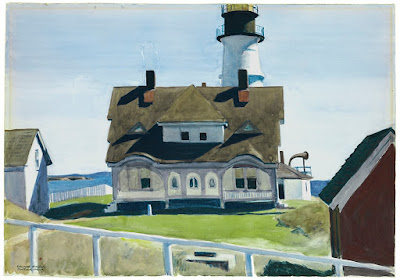The Myterieous Beauty of Edward Hopper's Captain Strout's House
This is one of my all time favorite paintings, a watercolor by Edward Hopper, Captain Strout's House, Portland Head from 1927. It's in the collection of the venerable Wadsworth Atheneum in Hartford, CT (founded in 1842!). The light and color of the painting are amazing. Yet I always sensed there was something beyond that but I couldn't put my finger on it. I think this painting points to how playful spontaneity and unconscious thinking makes the art happen.
In our kitchen each year we always have a wall calendar that features Hopper paintings. One evening as I was scrubbing a frying pan I paused and glanced up at the calendar. That month featured a big reproduction of Captain Strout's House. My eye fastened on the far watery horizon and a mental alarm bell went off. The water to the left of the house was way higher than the water level on the right. They didn't come close to lining up with each other. How could this be?
Looking a little longer I realized my eye liked the discontinuous levels of the water. It added a hidden syncopation to the painting. I was amazed I'd never noticed this before about the painting-probably because the disconnected levels of the water fit into the overall composition so perfectly.
There's a skinny fence rail in the immediate foreground that most of us tend to pay little mind to. Notice how the rail slopes down diagonally from left to right. Then compare the two spots where the ocean disappears behind the walls of the house. These two water levels imply a hidden diagonal that runs exactly parallel to the sloping foreground fence railing.
Hopper was famous for his long searches after just the right subject matter. Once he found this exceptionally good subject and viewpoint I bet he was chomping on the bit to do the painting. He painted this watercolor from direct observation, beginning by quickly drawing in pencil the angles he saw. His hand would have been guided by careful optical measuring but also pushed and pulled by the sensations the view was having on him. I believe he unconsciously altered the horizon lines to make them mimic the thrust he felt in the fence. I suspect he didn't notice the what he had done until later. He probably liked how this "accident" energized and made this landscape less ordinary.
We can't know if my theory about Hopper's painting is correct. He was notorious for saying and writing almost nothing to explain his work. But we do have this glowing little painting. To me that matters way more.



